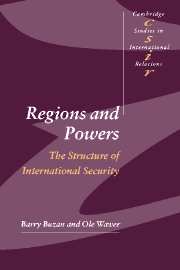Book contents
- Frontmatter
- Contents
- List of illustrations
- Preface
- List of abbreviations
- 1 Patterns of regional security during the Cold War
- 2 Patterns of regional security post-Cold War
- Part I Introduction: developing a regional approach to global security
- Part II Asia
- Introduction
- 4 South Asia: inching towards internal and external transformation
- 5 Northeast and Southeast Asian RSCs during the Cold War
- 6 The 1990s and beyond: an emergent East Asian complex
- Conclusions: scenarios for the Asian supercomplex
- Part III The Middle East and Africa
- Part IV The Americas
- Part V The Europes
- Part VI Conclusions
- Glossary
- References
- News media
- Index of names
- General Index
- CAMBRIDGE STUDIES IN INTERNATIONAL RELATIONS
4 - South Asia: inching towards internal and external transformation
Published online by Cambridge University Press: 05 December 2009
- Frontmatter
- Contents
- List of illustrations
- Preface
- List of abbreviations
- 1 Patterns of regional security during the Cold War
- 2 Patterns of regional security post-Cold War
- Part I Introduction: developing a regional approach to global security
- Part II Asia
- Introduction
- 4 South Asia: inching towards internal and external transformation
- 5 Northeast and Southeast Asian RSCs during the Cold War
- 6 The 1990s and beyond: an emergent East Asian complex
- Conclusions: scenarios for the Asian supercomplex
- Part III The Middle East and Africa
- Part IV The Americas
- Part V The Europes
- Part VI Conclusions
- Glossary
- References
- News media
- Index of names
- General Index
- CAMBRIDGE STUDIES IN INTERNATIONAL RELATIONS
Summary
The argument in this chapter is that the security dynamics on the domestic, regional, and global levels show a lot of continuity. But the strengthening of the Asian supercomplex means that the interregional level is rising in importance relative to the others, and the bipolar structure at the regional level is weakening as Pakistan loses ground in relation to India. The first section briefly summarises the development, structure, and operation of the South Asian conflict formation during the Cold War. The next section looks at how the complex has evolved since the ending of the Cold War, asking whether it has remained essentially stable in form, or is showing signs of transformation. The third section concludes by considering the outlook for the South Asian RSC.
The South Asian RSC during the Cold War: decolonisation to conflict formation
South Asia has been examined in depth using RSCT (Buzan, Rizvi et al. 1986), so here we focus on bringing the study and the interpretation up to date, and locating the South Asian story more systematically in an all-Asia context.
The South Asian RSC, like most other postcolonial security regions, came into being as a conflict formation. India and Pakistan were born fighting each other in 1947 when what had been a societal security problem of religious conflict between the Muslim League and the Congress Party was transformed into an interstate, military-political one between an Islamic Pakistan and a secular, multicultural, but dominantly Hindu India.
- Type
- Chapter
- Information
- Regions and PowersThe Structure of International Security, pp. 101 - 127Publisher: Cambridge University PressPrint publication year: 2003
- 1
- Cited by



